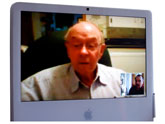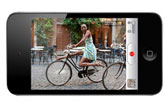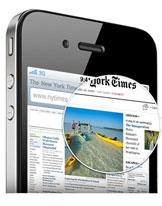
Technological overload and the iPad
FTLComm - Tisdale - Thursday, November 18, 2010
Since this web site began back in 1998 we have posted stories about technology, primarily about computers and computer software. As we have gone along, there have been some remarkable changes in both, but the most dramatic change of all, is the diffusion, as the power of the micro chip expands and with it, the way we in turn, are finding ways to turn silicon chips into magical tools.
Initially the issue was how we could communicate with the machine and its software (commands). The keyboard was a good start because it was the transference of a technology already in place and the early computers were operating solely by line input commands. Somewhere before 1980 the folks at Xerox in Palo Alto California began using a pointing device we have come to know as a mouse working with a graphic interface to make the computer do what we want. The first commercial product to use a mouse was the Apple Lisa that became available in January 1983, the version we have is a 1984 model. Costing about $15,000 Canadian this remarkable computer was a revolutionary failure that led to the development of the Apple Macintosh. The Mac continues in various forms to this day. But, the basic graphic concept is the foundation of all computers currently in use.
When my oldest son brought home a Newton in the fall of 1993 we were amazed. A tiny low powered computer that you used with a sort of pen and wrote on its screen. The thing could sort of read hand writing and had some clever software to record contacts, phone numbers and keep notes. All very useful capabilities but it was expensive and a failure in the marketplace as was the educational keyboard equipped quasi-computer called the E-mate and one of my sons has one of these odd-ball machines.
The Newton and the eMate had taken a different direction from the conventional idea of what a computer should be and do and though they died in 1998 the concepts and development was not forgotten as the computer industry was clearly evolving. The PalmPilot showed up in the spring of 1997 and was reasonably priced and pretty incompetent when compared with the Newton. However, it did what it was intended to do and was definitely successful in the business marketplace. Ultimately a device of any kind depends for its success on the use made of it.
When you apply this principle of use to the computer we discover that from its beginning there were people who used them to play games with, create and play music, develop art work and with the Internet in 1995, use the computer to access the information and new available on the planet. For most of us the primary use of the connection from computer to computer or computer systems is e-mail. The world wide web is the information provider for most people today and the acquisition of music, video and motion pictures has steadily developed through out the brief history of the device.
Though we had computer video conferencing in November of 2000 it was by no means main stream but by November 2005 using the computer to talk face to face with people on line was part of the Macintosh operating system and is about to be replaced shortly with a more standard and more stable successor.
It was back in 1999 I did a story on watching television on your computer and things have come a long way since then. So much so that I know a fellow who does not have cable, a dish or broadcast antenna, instead he downloads his television and movies, commercial free, to his computer/server then views the content on his plasma screen.
The first device to bring most of these diverse technologies together was the iPod. Intended originally as a device to play back downloaded music and marketed in the fall of 2001. It evolved into a device with a LCD screen and was called the iPod Touch. It came on the market in 2007 and was immediately the place to put and look at your pictures, view movies and with its WiFi capability surf the Web. It seemed no time until everyone in our family had one with the exception of me. It was truly astonishing what could be done with this device and it set pattern that would follow. Because of its enormous range of capabilities including e-mail and later cameras and sound recording, that it was up to the user who was determining what they would do with these things. My four and five year-old grand daughters each use iPod Touches almost every day watching television, movies or family picture albums.
It was in the late 1990s that cellular telephones became available. I remember my son’s first phone being something the size of a brick. Other family members soon had bag phones in their cars and I used one up to a couple of years ago. The cell phone is a cool device and became even cooler when it became digital instead of analog giving it the ability to exchange text messages. The Canadian company RIM produced the BlackBerry in 2002 that could handle e-mail and access the web. It was outstanding and quickly became the most important possession of every person in business and politics. It and others like it are referred to as “smartphones” and with good reason. Though they are phones they are definitely much more.
In 2007 the iPhone was introduced and it put all of the stuff we have been discussing here in one handful of technology. But it also incorporated things that were sneaking into all cell phones, things like GPS and would even tag pictures taken with the iPhone’s camera with the location the picture was taken. The latest version, the G4 has cameras front and back so that with this device you can now talk face to face with other iPhone G4 owners or with anyone using a modern Intel equipped Mac computer just by clicking on the e-mail address in the contact application.
The key to all of these developments right from the very start has been the programming, the set of instructions the computing device follows to carry out its tasks. By the end of the 1990s computer applications had grown to mammoth proportions using up huge amounts of storage and offering far more capability than any user could ever need. Word and Excel from Microsoft and Photoshop from Adobe are really big and equally really expensive. Apple spotted this issue and as years have gone by has included a lot of the basics right into the computer operating system. It just seems unlikely that any of us need $1,200 dollar software to fix up our digital pictures. With this in mind the iPod Touch and the iPhone share tiny little applications that are specific as to what they do and are ridiculously inexpensive or free. They are obtained from Apple through its music marketing site iTunes and there are over 200,000 of these “apps”.
While have been leading up to the present combination of these technologies the modern computer is still a remarkable beast. With the exception of making a cell phone call our desk top computers can do all of the above and laptops can handle the cell phone and GPS tasks. What is obvious is that the trends that have produced smartphones and the iPhone are returning as part of the computer operating system and software. Apple will shortly be offering Macintosh apps similar to those for the iPhone, iPod Touch and iPad. This evening we placed several video calls to an iPhone G4 using the same software as the iPhone from my Mac Mini.
We got our iPad on the Thanksgiving weekend and life really hasn’t been the same since. Suppose some one gave you the magical portal that you can hold on your lap or sit on a table and through that touch screen see full newspapers from almost anywhere in the world. Browse through magazines that look better on the screen then they ever possibly could in print and read books, watch videos, listen to music, listen to live radio play a game, check your e-mail, write report or look up almost any fact you can think of and all this happens very quickly. There simply isn’t enough time to even sample the capabilities of the iPad. Our version works on WiFi and has a battery life of more than ten hours. Though ours also has the capability of accessing the Internet over the cellular telephone system we are waiting for SaskTel to get its act together so we can add this remote capability and have the use of the device in the car.
With this month’s experience I can see far into the future as we as a society will move toward the use of less and less paper, smaller back packs for school and college and this is only the first version of the iPad. I know people with both the Kindle and Sony readers and they are equally amazing things though more specific in what they can do. For many people the wide range of the iPad may not be necessary, nor might they want to be connected away from a WiFi network link.
I really am a news junky and before the iPad was available to me I was spending a lot of time socking up world news on the computer. If you want to take a look at some of the various news sources I have a page of bookmarks for you to try out.





















